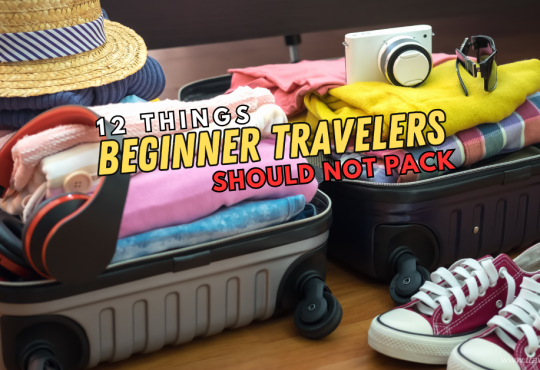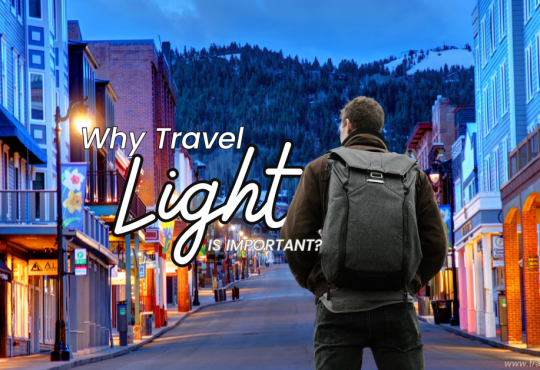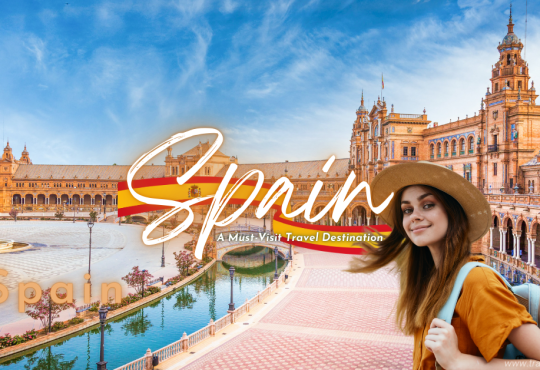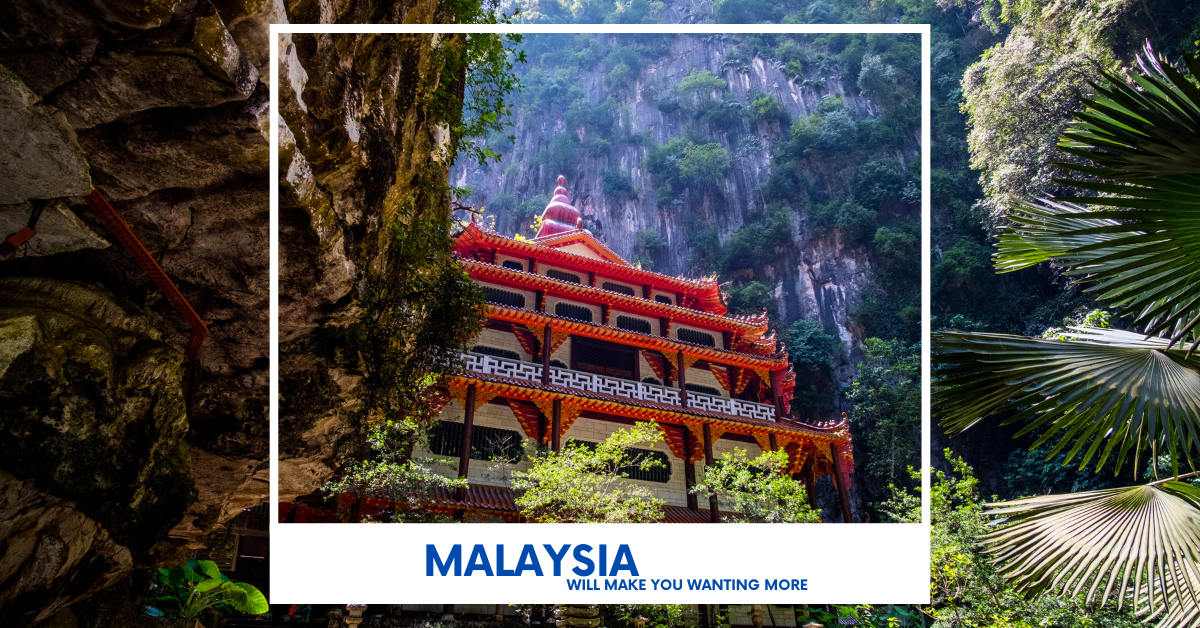
When it comes to Southeast Asia, Malaysia is one of the most diverse, vibrant, and welcoming countries you could explore. From bustling cityscapes and tranquil islands to lush jungles and cultural heritage sites, Malaysia has something for every kind of traveler. This country, split between the Malay Peninsula and the island of Borneo, is full of unique experiences that capture the rich history and multicultural blend of Malay, Chinese, Indian, and indigenous influences. But with so much to offer, where do you begin?
If you’re planning a trip and are eager to find the best things to do in Malaysia, look no further. Here’s a rundown of must-visit places, must-try foods, and can’t-miss experiences that will make your journey unforgettable. Whether you’re an adventurous soul, a food enthusiast, or a cultural explorer, Malaysia has surprises waiting at every corner.
Iconic Places to Visit in Malaysia
1. Kuala Lumpur—The City That Never Sleeps
Kuala Lumpur, Malaysia’s capital, is a world-class city known for its futuristic skyline, shopping centers, and eclectic nightlife. Here are some highlights you shouldn’t miss:
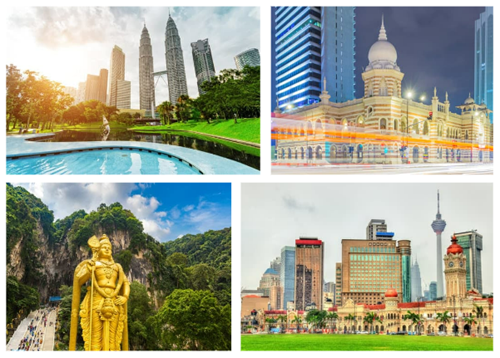
- Petronas Twin Towers: These iconic towers are the pride of Malaysia and a must-see landmark. Standing at 452 meters, they were once the tallest buildings in the world. Head up to the Sky Bridge, located on the 41st floor, for stunning views of the city. Don’t forget to capture photos of the beautiful park below, which is perfect for a leisurely stroll.
- Batu Caves: Located just outside Kuala Lumpur, these limestone caves house Hindu temples and shrines and are guarded by a colossal golden statue of Lord Murugan. Climbing the 272 colorful steps to reach the caves is an experience in itself. The caves are also home to many monkeys, so keep your belongings secure! Visiting during Thaipusam (usually in January or February) allows you to witness a vibrant festival with elaborate processions.
- Chinatown and Jalan Alor: For those craving local delicacies, Kuala Lumpur’s Chinatown and Jalan Alor Street Food Night Market offer authentic Malaysian dishes in a vibrant setting. Try dishes like Hokkien Mee, char kway teow, and grilled satay. The area is alive with street performers, and the neon lights create a festive atmosphere in the evening.
- Merdeka Square: This historical site is where Malaysia declared its independence from British rule. The square features the Sultan Abdul Samad Building, a beautiful example of Moorish architecture, and the 95-meter high flagpole, which is one of the tallest in the world. It’s a great place to learn about Malaysia’s history and enjoy the surrounding green space.
Kuala Lumpur makes the travel and shops experience truly memorable
Kuala Lumpur (KL) is a vibrant city that offers an exciting travel and shops experience for visitors. Its efficient public transportation system, including the Light Rail Transit (LRT), Mass Rapid Transit (MRT), and Monorail, makes it easy to navigate key shopping districts like Bukit Bintang, home to upscale malls such as Pavilion Kuala Lumpur and Lot 10. For those looking for unique finds, local markets like Central Market and Petaling Street provide a rich cultural experience with opportunities to haggle for traditional crafts, souvenirs, and delicious street food. The free Go KL City Bus service is another convenient way to explore the city center without breaking the bank.
Shopping in KL is complemented by a diverse dining scene, with food courts and restaurants in major malls offering everything from local delicacies to international cuisine. Bargaining is common in local markets, making it an engaging experience for tourists. With most malls open from 10 AM to 10 PM and many markets staying open later, visitors can enjoy both shopping and dining at their leisure. For a well-rounded experience, don’t forget to take breaks at cafes and indulge in the culinary delights that Kuala Lumpur has to offer.
2. Penang—The Food Paradise
Known as the food capital of Malaysia, Penang is famous for its street food, but it also boasts charming streets lined with colonial buildings and temples.
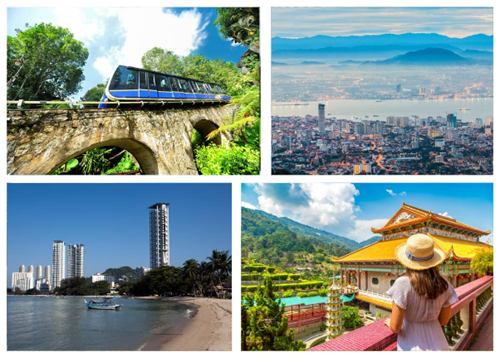
- George Town: A UNESCO World Heritage Site, George Town is known for its colorful murals, colonial architecture, and traditional street food. Don’t miss the Street Art by local artists that adorns many buildings, providing a perfect backdrop for photos. You can also explore the numerous clan jetties, wooden stilt houses built by Chinese immigrants.
- Penang Hill: Take a funicular ride to Penang Hill for cool breezes and stunning views of the island. At the top, visit The Habitat, an interactive eco-educational park, and the David Brown’s Restaurant and Tea Terraces for a relaxing meal with panoramic views.
- Penang Street Art: Wander around George Town to find street art that tells stories of the city’s history and multicultural heritage. The art includes famous works by local artist Ernest Zacharevic, and exploring on foot or by bicycle is the best way to appreciate it.
- Kek Lok Si Temple: This is the largest Buddhist temple in Malaysia, located in Air Itam. The temple complex features beautiful architecture, a giant statue of the Goddess of Mercy, and offers fantastic views of the city. Visit during the Chinese New Year for the breathtaking lantern display.
3. Langkawi—The Jewel of Kedah
Langkawi, an archipelago of 99 islands, is a paradise for beach lovers and nature enthusiasts.
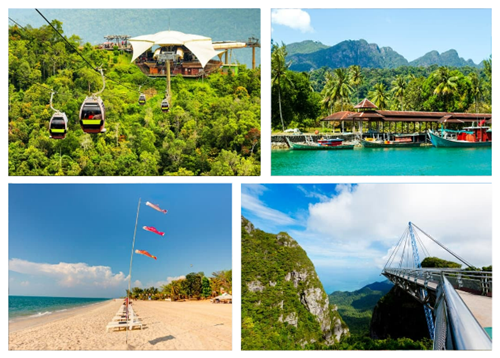
- Langkawi Sky Bridge: Suspended above the mountains, this curved bridge offers panoramic views that stretch as far as Thailand. You can take a cable car ride to the top of Gunung Mat Cincang, where the bridge is located. Make sure to visit early in the morning to avoid crowds and enjoy clearer skies.
- Pantai Cenang: Langkawi’s most popular beach is known for its white sands, water sports, and lively nightlife. Here, you can indulge in various activities, from jet-skiing and parasailing to relaxing at beach bars and restaurants. The sunset views are breathtaking, so plan to stay until dusk.
- Kilim Karst Geoforest Park: Explore the mangrove forests, limestone formations, and caves on a guided boat tour. The park is rich in biodiversity and offers opportunities to see wildlife, including eagles and monkeys. Guided tours often include stops at hidden lagoons and floating fish farms.
- Underwater World Langkawi: One of the largest aquariums in Malaysia, this attraction features a wide variety of marine life. The underwater tunnel offers a unique view of sharks, rays, and other sea creatures swimming around you. It’s a great family-friendly destination.
4. Borneo—For Nature Lovers
Borneo’s Malaysian states, Sabah and Sarawak, are famous for their rainforests, wildlife, and indigenous cultures.
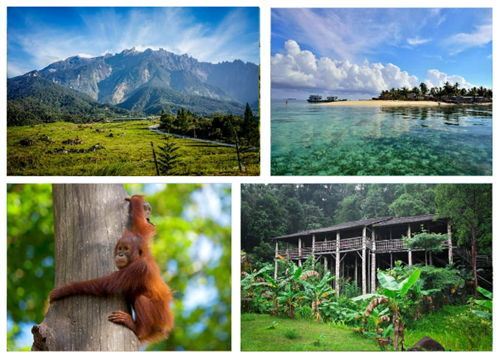
- Mount Kinabalu: Hike up one of Southeast Asia’s highest peaks, offering scenic views for adventurous trekkers. The climb usually takes two days, with an overnight stay at a mountain lodge. Make sure to book your climb in advance, as permits are limited.
- Sepilok Orangutan Rehabilitation Centre: Visit Sabah to see rescued orangutans and learn about conservation efforts. The center provides an educational experience, and the feeding sessions, usually at 10 a.m. and 3 p.m., offer a chance to observe these magnificent creatures up close.
- Sarawak Cultural Village: Discover the unique culture of Sarawak’s indigenous people in this “living museum.” The village showcases traditional longhouses from various ethnic groups, and you can enjoy cultural performances and demonstrations, such as blowpipe shooting and cooking.
- Bako National Park: Famous for its diverse ecosystems, Bako National Park is a must-visit for nature enthusiasts. You can hike various trails to see wildlife like proboscis monkeys and various bird species, and the park offers beautiful coastal views and beaches.
5. Cameron Highlands—The Hill Station Haven
If you need a break from the tropical heat, Cameron Highlands provides a cooler climate, tea plantations, and strawberry farms.
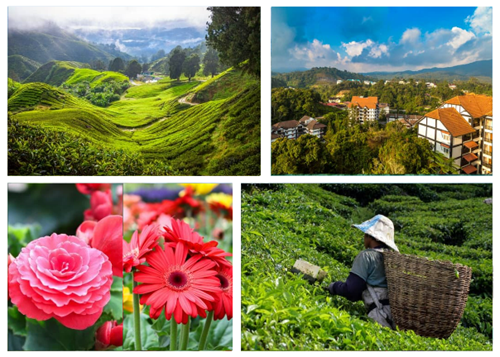
- Boh Tea Plantation: Take a guided tour to see how tea is grown, harvested, and processed. You can also enjoy a cup of freshly brewed tea at the on-site café with stunning views of the plantation.
- Mossy Forest: A mystical forest where you can see pitcher plants, wild orchids, and moss-covered trees. Guided tours are available, and you can learn about the unique flora and fauna of this ecosystem.
- Strawberry Farms: Try fresh strawberries and pick some if you visit during the right season. Many farms offer fun activities, such as strawberry picking, as well as delicious strawberry-based treats like ice cream and jam.
- Night Markets: Visit the night markets in Brinchang for local handicrafts, fresh produce, and street food. The atmosphere is lively, with vendors selling everything from souvenirs to unique snacks.
Unmissable Foods to Try in Malaysia
Malaysian cuisine is a delicious fusion of Malay, Chinese, Indian, and indigenous flavors. Here are the top dishes you should try, along with more useful details about each:
1. Nasi Lemak: Widely regarded as Malaysia’s national dish, nasi lemak is rice cooked in coconut milk, giving it a rich and creamy flavor. It is typically served with sambal (a spicy chili paste), crispy fried anchovies, boiled eggs, roasted peanuts, and cucumber slices.
- Variations: Some variations include fried chicken, rendang (a slow-cooked meat dish), or squid.
- Where to Find: You can find nasi lemak at roadside stalls, local restaurants, and even in upscale dining establishments. Popular spots include Nasi Lemak Antarabangsa in Kuala Lumpur and Nasi Kandar Line Clear in Penang.
2. Char Kway Teow: This Penang specialty features flat rice noodles stir-fried with prawns, cockles, Chinese sausage, eggs, bean sprouts, and chives, all cooked in a hot wok with soy sauce. The dish is known for its smoky flavor, referred to as “wok hei.”
- Variations: Some versions add crab or are made with a spicy chili paste for added heat.
- Where to Find: You can find excellent char kway teow at hawker stalls throughout Penang, with one of the most famous being Char Kway Teow Taman Emas.
3. Laksa: There are two popular variations of laksa in Malaysia:
-
- Curry Laksa: A coconut milk-based curry noodle soup loaded with shrimp, tofu, and bean sprouts, garnished with fresh herbs.
- Assam Laksa: A tangy fish-based soup made with mackerel, tamarind, and a variety of herbs, served with rice noodles and topped with cucumber, onions, and mint.
- Where to Find: Head to Penang for assam laksa, especially at Ayer Itam Market. For curry laksa, check out Kuala Lumpur’s Village Park Restaurant.
4. Satay: Satay consists of marinated skewered and grilled meat, typically chicken, beef, or lamb, served with a spicy peanut sauce. It’s often accompanied by cucumber, onions, and rice cakes known as ketupat.
- Variations: Different regions may have their own unique marinades, and some variations include lamb or fish.
- Where to Find: Look for satay at night markets or specialized satay stalls. Sate Kajang Haji Samuri is a popular chain known for its delicious satay in Kajang, just outside of Kuala Lumpur.
5. Roti Canai: Roti canai is an Indian-inspired flatbread made from dough that is stretched and flipped until it’s thin and flaky before being fried. It is often served with dhal (lentil curry) or other curries for dipping.
- Variations: Some variations include stuffed roti with ingredients like cheese, eggs, or minced meat, while roti tissue is an ultra-thin, crispy version.
- Where to Find: Roti canai is available at most mamak (Indian-Muslim) restaurants. Popular spots include Nasi Kandar Pelita and Roti Canai Transfer Road in Penang.
6. Cendol: For dessert, try cendol, a shaved ice treat topped with green rice flour jelly (cendol), coconut milk, and palm sugar syrup. It’s a refreshing dessert that is perfect for cooling off in Malaysia’s tropical climate.
- Variations: Some versions include red beans, sweet corn, or even durian for an added kick.
- Where to Find: You can find cendol at street vendors and dessert shops. A well-known spot is Penang Road Famous Teochew Chendul in Penang, which often has long lines of eager customers.
7. Rendang: Rendang is a rich and tender coconut beef stew slow-cooked with lemongrass, galangal, turmeric, ginger, and chilies until the meat is flavorful and the sauce thickens. Although it originates from Indonesia, it’s widely enjoyed in Malaysia.
- Variations: Besides beef, rendang can be made with chicken or even vegetables for a vegetarian option.
- Where to Find: Many Malay restaurants serve rendang. You can try it at Warung Nasi Pariaman in Kuala Lumpur or various local food stalls.
8. Hokkien Mee: This dish consists of thick egg noodles stir-fried in a dark soy sauce with shrimp, pork, squid, and vegetables, often topped with crispy pork lard and served with sambal on the side.
- Variations: There are variations, including a lighter version that uses a seafood broth instead of dark soy sauce.
- Where to Find: Famous in Kuala Lumpur, head to Kim Lian Kee for their delicious rendition.
9. Asam Pedas: A spicy and tangy fish stew made with tamarind, chilies, and a variety of herbs and spices. This dish is particularly popular in Melaka and is known for its bold flavors.
- Variations: Asam pedas can be made with various types of fish, such as mackerel or snapper.
- Where to Find: Visit Restoran Asam Pedas Selera Kampung in Melaka for a traditional experience.
10. Nasi Kandar: Nasi kandar is a dish that consists of steamed rice served with a variety of curries and side dishes. Diners typically choose their curries from a display, allowing for a personalized meal.
- Variations: The curries can include chicken, beef, fish, and vegetarian options, and it’s often accompanied by fried chicken or squid.
- Where to Find: Nasi Kandar Line Clear in Penang is famous for its flavorful curries, while Pelita Nasi Kandar has branches across the country.
Best Things to do in Malaysia—Exciting Activities
Malaysia offers a diverse range of activities that cater to thrill-seekers, culture enthusiasts, and nature lovers alike. Here are some exciting activities to add to your itinerary:
1. Island Hopping in Langkawi
Langkawi is known for its stunning islands and crystal-clear waters, making island hopping a must-do activity. You can visit various islands, each offering unique landscapes and experiences.
- Key Islands:
- Pulau Dayang Bunting: Famous for its “Pregnant Maiden Lake,” a freshwater lake surrounded by lush greenery. Enjoy a swim or take a kayak to explore the serene surroundings.
- Pulau Beras Basah: Known for its white sandy beaches, it’s a great spot for swimming and sunbathing.
- Pulau Payar Marine Park: A fantastic location for snorkeling and diving, with vibrant coral reefs and diverse marine life.
- Tips: Join a guided tour to ensure a hassle-free experience. Most tours include snorkeling gear, meals, and refreshments.
2. Trekking in Taman Negara
Taman Negara is one of the oldest rainforests in the world, and it offers an incredible trekking experience for nature lovers.
- Trekking Routes:
- Canopy Walkway: Experience the forest from above on this 510-meter long suspended walkway, which is about 40 meters high. It’s an exhilarating way to see the forest’s biodiversity.
- Jungle Trekking: Several trails cater to different fitness levels, from easy strolls to challenging hikes that can last several hours. Look out for unique wildlife, such as monkeys, hornbills, and even the elusive Malayan tiger.
- Tips: Book a guided trek for a more informative experience. Remember to wear sturdy shoes, carry plenty of water, and apply insect repellent.
3. Caving in Batu Caves
Located just outside Kuala Lumpur, Batu Caves is a limestone hill featuring a series of caves and cave temples. The main cave houses a Hindu temple and is famous for its massive golden statue of Lord Murugan.
- Activities:
- Explore the Caves: Climb the 272 steps to reach the main cave, and take time to explore the smaller caves, which feature colorful statues and paintings.
- Adventure Caving: For thrill-seekers, opt for guided adventure caving tours that include rock climbing and rappelling in the surrounding limestone hills.
- Tips: Visit during the Thaipusam festival (usually in January or February) for a vibrant cultural experience. Wear comfortable shoes and be prepared for the climb.
4. Skydiving in Kuala Lumpur
For adrenaline junkies, skydiving over Kuala Lumpur offers an unparalleled thrill and stunning views of the city skyline.
- Experience: Tandem skydiving is available for beginners, where you’ll be harnessed to an experienced instructor. After a brief training session, you’ll ascend to altitude before jumping out of the plane for an exhilarating free-fall.
- Tips: Book your jump in advance, and check the weather conditions as jumps may be rescheduled due to poor visibility. Wear comfortable clothing and closed-toe shoes.
5. Wildlife Watching in Borneo
Malaysia’s Borneo offers some of the best wildlife experiences in Southeast Asia, particularly in Sabah and Sarawak.
- Activities:
- Orangutan Watching: Visit the Sepilok Orangutan Rehabilitation Centre to see rescued orangutans and learn about conservation efforts.
- Kinabatangan River Cruise: Take a river cruise to spot wildlife such as proboscis monkeys, pygmy elephants, and various bird species in their natural habitat.
- Mulu Caves National Park: Explore one of the world’s largest cave systems, home to impressive limestone formations and diverse wildlife.
- Tips: Opt for guided tours for a more enriching experience and to increase your chances of spotting wildlife. Bring binoculars and a good camera for photography.
6. Cultural Experiences in Melaka
Melaka, a UNESCO World Heritage site, offers rich historical and cultural experiences that reflect Malaysia’s diverse heritage.
- Activities:
- Explore Jonker Street: This bustling street comes alive at night with food stalls, shops, and street performances. Don’t miss trying local delicacies like chicken rice balls and cendol.
- Visit Historical Sites: Discover the rich history of Melaka by visiting attractions such as the A Famosa fortress, St. Paul’s Hill, and the Stadthuys (Red Square).
- Baba Nyonya Heritage Museum: Learn about the Peranakan culture through exhibits showcasing traditional clothing, furniture, and cuisine.
- Tips: Consider joining a guided heritage walk to gain insights into Melaka’s history and culture. Wear comfortable shoes, as you’ll be walking a lot.
7. Diving in Sipadan
Sipadan Island is regarded as one of the top diving destinations in the world. Its rich marine biodiversity includes turtles, sharks, and colorful coral reefs.
- Diving Experience: Divers can explore famous sites such as Barracuda Point, where schools of barracuda are often seen, and Turtle Cavern, known for its underwater tunnels.
- Tips: Book your diving trips in advance, as permits are limited to preserve the marine environment. Ensure you have the necessary diving certification for certain sites, and remember to check equipment rentals with your dive operator.
8. Shopping in Kuala Lumpur
Kuala Lumpur is a shopper’s paradise, with a mix of modern shopping malls, traditional markets, and street vendors.
- Top Shopping Destinations:
- Bukit Bintang: This vibrant area is home to high-end malls like Pavilion KL and Lot 10, as well as street markets offering local goods.
- Central Market: A cultural landmark where you can find traditional handicrafts, souvenirs, and delicious local snacks.
- Petaling Street (Chinatown): Famous for its bargain shopping and vibrant atmosphere, you can find everything from clothing to street food.
- Tips: Bargaining is common at markets, so don’t hesitate to negotiate prices. Keep an eye out for seasonal sales and promotions in malls.
9. Attend Festivals and Events
Malaysia is known for its vibrant festivals that showcase its multicultural heritage.
- Popular Festivals:
- Hari Raya Aidilfitri: Celebrated by Muslims, this festival marks the end of Ramadan with prayers, feasting, and visiting family and friends.
- Chinese New Year: A lively festival marked by lion dances, fireworks, and family gatherings, celebrated with traditional foods and decorations.
- Deepavali: Known as the Festival of Lights, Hindus celebrate with colorful rangoli designs, prayers, and festive feasts.
- Tips: Check the festival dates in advance, as they vary each year. Participating in local celebrations is a great way to immerse yourself in the culture.
Malaysia Must-Visit Cities to Explore for a Complete Malaysian Experience
Malaysia is a melting pot of cultures, traditions, and landscapes, and each city offers its own unique experiences. Here are some of the best cities to explore for a complete Malaysian adventure:
1. Kuala Lumpur
As the capital city of Malaysia, Kuala Lumpur (KL) is a vibrant metropolis known for its modern skyline, rich history, and cultural diversity.
- Key Attractions:
- Petronas Twin Towers: Once the tallest buildings in the world, these iconic towers feature a sky bridge and observation deck offering stunning views of the city.
- Batu Caves: A limestone hill with a series of caves and cave temples, it’s a significant Hindu shrine and a popular tourist destination.
- Merdeka Square: This historical site is where Malaysia declared independence from British rule in 1957. The surrounding colonial buildings add to its charm.
- Bukit Bintang: The shopping and entertainment district, bustling with malls, restaurants, and nightlife.
- Cultural Insights: KL is a cultural melting pot, with Malay, Chinese, and Indian influences evident in its food, architecture, and festivals.
- Tips: Use the efficient public transport system (LRT, MRT) to navigate the city easily. Don’t miss the street food at Jalan Alor for an authentic local dining experience.
2. George Town, Penang
The capital of the state of Penang, George Town is known for its well-preserved colonial architecture, vibrant street art, and rich culinary scene. It is a UNESCO World Heritage site.
- Key Attractions:
- Street Art: Explore the streets to find murals and installations created by local and international artists, telling stories about the city’s history and culture.
- Cheong Fatt Tze Mansion (The Blue Mansion): A historic building that reflects the fusion of Eastern and Western architectural styles, offering guided tours to learn about its history.
- Penang Hill: Take the funicular train to the top for panoramic views of the island and visit The Habitat, which features a canopy walk and historical exhibits.
- Cultural Insights: Penang is renowned for its street food, blending Malay, Chinese, and Indian flavors. The local cuisine is a highlight of any visit.
- Tips: Rent a bicycle to explore the city at your own pace. Visit during the George Town Festival in August for a taste of local arts and culture.
3. Malacca (Melaka)
A historical city that showcases Malaysia’s colonial past, Malacca is famous for its unique blend of cultures and historical sites. It is also a UNESCO World Heritage site.
- Key Attractions:
- A Famosa: The remains of a Portuguese fortress, one of the oldest surviving European structures in Southeast Asia.
- Stadthuys: The iconic red building that houses the History and Ethnography Museum, providing insights into Malacca’s rich history.
- Jonker Street: A bustling street market known for its food, shopping, and nightlife, especially vibrant during the weekends.
- Cultural Insights: The city’s rich history is reflected in its architecture, cuisine, and festivals, showcasing Malay, Chinese, Portuguese, and Dutch influences.
- Tips: Take a river cruise along the Malacca River for a different perspective of the city. Visit during the Malacca River Festival for cultural performances and activities.
4. Kota Kinabalu
The capital of Sabah in Borneo, Kota Kinabalu is a gateway to stunning natural beauty, including beaches, islands, and Mount Kinabalu.
- Key Attractions:
- Mount Kinabalu: A UNESCO World Heritage site and the highest peak in Southeast Asia, popular for hiking and climbing. The ascent offers breathtaking views and diverse flora and fauna.
- Tunku Abdul Rahman Park: A group of islands perfect for snorkeling, diving, and relaxing on the beach, just a short boat ride from the city.
- Gaya Street Sunday Market: A lively market where you can find local handicrafts, fresh produce, and delicious street food.
- Cultural Insights: Kota Kinabalu is home to various indigenous communities, and visitors can learn about their traditions and cultures through local tours.
- Tips: Book your Mount Kinabalu climb in advance, as spots can fill up quickly. Bring sunscreen and insect repellent for outdoor activities.
5. Ipoh
Known for its colonial architecture and culinary delights, Ipoh is a charming city in Perak, often overlooked by travelers but worth exploring.
- Key Attractions:
- Kellie’s Castle: A historical mansion with an intriguing backstory, it showcases Moorish architecture and offers guided tours.
- Perak Cave Temple: A stunning temple built into a limestone hill, featuring beautiful murals and Buddha statues.
- Concubine Lane: A historic street lined with cafes, boutiques, and street food stalls, offering a glimpse into the city’s past.
- Cultural Insights: Ipoh is famous for its white coffee, a local specialty, and is home to various street food stalls serving local dishes like chicken rice and curry noodles.
- Tips: Spend a weekend in Ipoh to fully enjoy the culinary scene and nearby attractions. Don’t miss the night markets for delicious snacks.
6. Brisbane
Though technically not a Malaysian city, it’s worth noting that many travelers from Malaysia have roots in this Australian city. It offers a unique blend of cultures, outdoor activities, and vibrant nightlife.
- Key Attractions:
- South Bank Parklands: A lush urban oasis featuring gardens, walking paths, and a man-made beach.
- Lone Pine Koala Sanctuary: The world’s first and largest koala sanctuary, where you can cuddle koalas and feed kangaroos.
- Queensland Art Gallery and Gallery of Modern Art (QAGOMA): Offers a wide range of exhibitions, including contemporary art from Australia and around the world.
- Cultural Insights: Brisbane has a diverse cultural scene influenced by Asian communities, evident in its cuisine and festivals.
- Tips: Visit during the Brisbane Festival in September for a showcase of music, dance, and art. Public transport is efficient, making it easy to get around the city.
7. Kuantan
The capital of Pahang, Kuantan is known for its beautiful beaches and as a gateway to national parks. It offers a more laid-back experience compared to larger cities.
- Key Attractions:
- Teluk Chempedak: A popular beach destination with soft sands, clear waters, and various water sports activities.
- Cherating: Known for its beautiful beach and as a surfing destination, it’s also home to traditional fishing villages and cultural experiences.
- Bukit Gambang Resort City: A resort complex featuring a water park, safari park, and various accommodation options.
- Cultural Insights: Kuantan showcases Malay culture, with traditional crafts and cuisine. The local food scene is vibrant, with seafood being a highlight.
- Tips: Visit during the weekends for beach activities and local markets. Sample local delicacies like “nasi dagang” and “keropok lekor.”
Tips for Traveling Around Malaysia
Traveling around Malaysia can be an exciting adventure filled with diverse experiences. Whether you’re exploring bustling cities, serene beaches, or lush jungles, here are some essential tips to help you navigate the country smoothly.
1. Transportation Options
- Public Transport:
- Kuala Lumpur: The city boasts an extensive public transport network, including the Light Rail Transit (LRT), Mass Rapid Transit (MRT), and Monorail. These systems are efficient, affordable, and connect major attractions. The KTM Komuter trains also link KL with surrounding areas.
- Buses: Intercity and state buses are an economical way to travel across Malaysia. Companies like Transnasional and Unititi offer comfortable services connecting major cities. Booking tickets online is convenient.
- Grab: This ride-hailing app is widely used in Malaysia and is often cheaper than traditional taxis. Grab offers various options, including cars and bikes, making it a convenient choice for short trips.
- Car Rentals:
- Renting a car can provide more flexibility, especially when exploring rural areas or national parks. Major rental companies operate in airports and cities. Ensure you have a valid international driving permit.
- Tip: Familiarize yourself with local driving rules and road conditions. Most roads are in good condition, but rural areas may have potholes or be less maintained.
- Domestic Flights:
- For long distances, especially between Peninsular Malaysia and Borneo, consider flying. Airlines like AirAsia and Malaysia Airlines offer frequent flights connecting major cities and islands.
- Tip: Book flights in advance for better deals and monitor for promotions.
2. Cultural Considerations
- Respect Local Customs: Malaysia is a multicultural nation with diverse customs and traditions. When visiting religious sites, dress modestly. For example, women should wear long skirts or trousers and cover their shoulders when entering mosques.
- Language: While Malay (Bahasa Malaysia) is the national language, English is widely spoken, especially in urban areas. Knowing a few basic Malay phrases can enhance your interactions and show respect for the local culture.
- Dining Etiquette: If you’re invited to a local home, it’s customary to remove your shoes. When dining, many locals eat with their hands, particularly in Malay culture. If you prefer using utensils, that’s perfectly acceptable as well.
3. Safety Tips
- Stay Vigilant: Malaysia is generally a safe country for tourists, but it’s wise to remain aware of your surroundings, especially in crowded areas or tourist spots. Keep valuables secure and avoid displaying large amounts of cash.
- Health Precautions: Drink bottled water to avoid stomach issues, especially in rural areas. Ensure you have travel insurance that covers medical emergencies. Vaccinations for diseases like Hepatitis A and Typhoid are advisable, depending on your travel itinerary.
- Emergency Numbers: Familiarize yourself with local emergency numbers. The police can be reached at 999, while ambulance services are also available through the same number.
4. Planning Your Itinerary
- Balance City and Nature: Malaysia is rich in urban experiences and natural wonders. Balance your itinerary between cities like Kuala Lumpur and Penang and nature destinations like Taman Negara or the Perhentian Islands.
- Consider Travel Times: Malaysia has a well-connected network, but travel times can vary. Allow extra time for long bus rides or train journeys, especially during peak travel seasons.
- Seasonal Considerations: The best time to visit Malaysia is during the dry season, typically from March to October. However, different regions may have varying weather patterns. For instance, the East Coast experiences monsoons from November to February, affecting beach activities.
5. Budgeting and Currency
- Currency: The official currency is the Malaysian Ringgit (MYR). ATMs are widely available in urban areas, but it’s good to carry some cash, especially in rural regions.
- Budget Accommodation: Malaysia offers various accommodation options, from luxury hotels to budget hostels. Websites like Booking.com and Agoda can help you find suitable lodging within your budget.
- Dining Costs: Eating at local food stalls and hawker centers is affordable and delicious. Meals can range from MYR 5 to MYR 30, depending on the venue. Don’t hesitate to try street food!
6. Connectivity
- SIM Cards: Purchasing a local SIM card upon arrival is recommended for internet access and calls. Major providers like Celcom, Digi, and Maxis offer tourist packages with data plans.
- Wi-Fi Availability: Many cafes, hotels, and public places provide free Wi-Fi, making it easy to stay connected during your travels.
7. Explore Off the Beaten Path
- Hidden Gems: While major cities and attractions are popular for a reason, don’t hesitate to explore lesser-known destinations. Places like Kota Bharu, Kuching, or the Cameron Highlands offer unique experiences away from the usual tourist routes.
- Engage with Locals: Interacting with local residents can lead to unexpected adventures and insights. Ask for recommendations on food, attractions, and hidden gems.
Immerse yourself in a vibrant culture
From the bustling city life in Kuala Lumpur to the serene beaches of Langkawi, Malaysia offers endless adventures, breathtaking views, and incredible food that will leave you wanting more. Whether you’re hiking in the highlands, diving in crystal-clear waters, or sampling street food, each experience adds to the rich tapestry that is Malaysia. The mix of modern and traditional, urban and natural, makes Malaysia a truly special destination with surprises around every corner.
So, if you’re planning your next travel adventure, consider Malaysia—it’s a destination where you’ll not only see incredible places but also immerse yourself in a vibrant culture. Embrace each city’s charm, savor each dish’s flavor, and enjoy the journey in one of Southeast Asia’s most welcoming and diverse countries.



